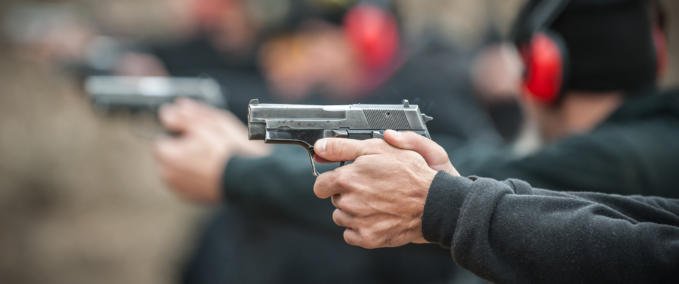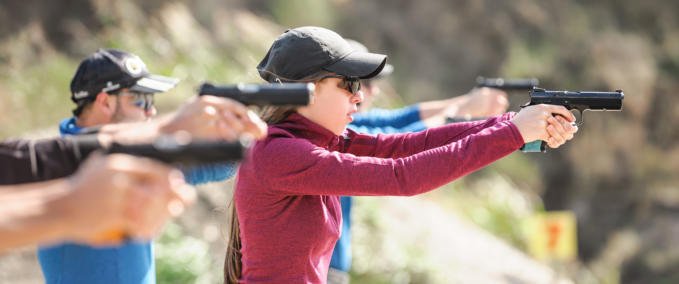

Close-up detail view of shooter practice handgun shooting on target in row group of people on the shooting range
Since the first introduction of firearms to the world, safety has been at the forefront of their usage. Firearms are used as a form of protection and defense but you're required to handle them well.
People are often unsure about how to handle firearms, whether it be in terms of hand placement, storage, cleaning, or any other factors that may come into play when handling them. Gun safety and the precaution attached to the use of firearms help prevent various firearm issues, such as malfunctions, accidental discharge, or any other problems associated with poor handling. Handling a firearm comes with responsibility and certain levels of gun care. The following are what many would describe as the rules of safe firearm handling:
1. Use A Secure Storage
Storing your gun safely, securely, and out of easy reach is an important aspect of firearm handling. If you’re frequently using your firearm, you may find it advantageous to keep it on your person, ideally through a holster. A holster is used to restrict the movement of a firearm you’re carrying.
You can get the best concealed carry holster in the form of a belt, an ankle holster, or any other secure holder. If you’re storing your gun within your home or a space with other people, you should store it in a hidden, unpredictable, and out-of-reach area. Preferably in a secure area that’s only known to or accessible by you.
2. Point The Muzzle In A Safe Direction
A muzzle is the opening at the end of a gun barrel. You have to make sure you're pointing the muzzle in a safe direction at all times because this is where the projectile exits the firearm and is the last point of contact between the projectile and the barrel.
Accidental discharge may occur at any moment if you're in possession of a firearm. Therefore, it's important to always point your gun in a direction that you intend to shoot in. Pointing your firearm in a safe direction should also be done when you're loading a gun, when it's loaded, as well as when you're unloading it because anything can happen.
A safe direction describes a point where no one could possibly be hit by a bullet from a firearm. This takes into consideration possible ricochets and any sort of wall penetration because bullets have that level of power. Up or down are the safest direction to point a muzzle to, particularly if everyone you're interacting with is within your horizontal point of contact.
Always make sure to use your firearm consciously and be consistently aware of where it's pointed at. This could save a life and make you feel safer.
3. Unload When Not In Use
Keeping a loaded gun in your pocket or bag or in any location that’s not secure when it's not in use should be avoided at all times. A firearm has a magazine, a chamber and a receiver and these should all be checked all the time in order to be sure your firearm doesn’t contain any bullets inside when not used. Sometimes we tend to forget that a gun contains ammunition, so it's important to open it and check whether it's loaded or not before using and before storing it.
One way of ensuring gun safety when not in use is to disassemble it and keep all the different parts apart and not put it together until you're going to use it. This is one of the safe ways of handling your firearm because it helps prevent anyone unauthorized from using your firearm.

Young people on tactical gun training classes. Shooting and Weapons. Outdoor Shooting Range
4. Wear Protective Gear
When handling a gun in any setting, it’s important to wear protective gear. Protective gear includes glasses, earplugs or earmuffs, gloves, or even a mask in case you have an allergic reaction to gun powder.
If you're in a shooting range or within a space where you may be continually hearing gunshots, ear protection may help prevent you from hearing damage. Sudden or continuous exposure to extremely loud noises can harm your eardrums, which may result in a range of hearing problems from minor hearing difficulties to developed deafness.
When shooting, good sight is also important to clearly identify your target without the influence of different levels of lighting. Eye protection may also be worn when you clean your firearm. This helps avoid possible injuries from the expulsion of various tension parts from the spring, solvents, or loose powder.
If you're in a range or in the wild, there may be branches, twigs, chips, or even possible malfunctions with weapons. Eye protection helps prevent potential injuries from these objects.
5. Know Your Firearm Well
A firearm needs to be handled delicately and consciously. You should be well informed on everything that makes up your firearm before handling it. This is something you can learn from instruction manuals, warnings, ammunition information, storage advice, and position analysis.
If you use the wrong ammunition in your gun, it may damage the gun and may even cause injury when used. Make sure to check each gauge or caliber as you load them into the cartridge. This is easier than having to recover from an injury.
Furthermore, as much as it's safe to know your firearm well and all its specifications, it's also important to make sure none of its components are damaged. Always ensure that your ammunition isn't substandard or any part of your gun is damaged because this helps make it easier for the gun to be handled.
6. Focus On Your Target
You should have an intention and purpose when you put your gun in your hands. You should be aware of the direction of your target and where you're looking to aim. Thereafter, you may consider putting your hands towards the trigger.
Knowing your target beforehand and treating your gun as if it can be fired at any moment may help become more careful when handling your firearm. Whether the safety catch on your firearm is on or not, you should handle your gun with care. The safety device acts as an accessory to good firearm handling. You should always make sure you turn the safety off once you're familiar with your target.
Shots cannot be reversed. Once the bullet leaves the gun, it's gone. Be aware of the direction of your bullet and everything beyond it. Always pay attention to your surroundings in case you lose control of your gun and lose sight of your target.
Handle Your Gun Well
Firearms are very dangerous weapons but are also excellent for shooting, protection, and self-defense. Whether it be purchasing a gun safe or using a holster, being careful when handling firearms is an ongoing learning journey. Always make sure to actively handle your firearm with care and be conscious of your environment while you're at it. If you can practice these tips, you can somewhat ensure that your safety and that of anyone within your proximity are taken into account.
